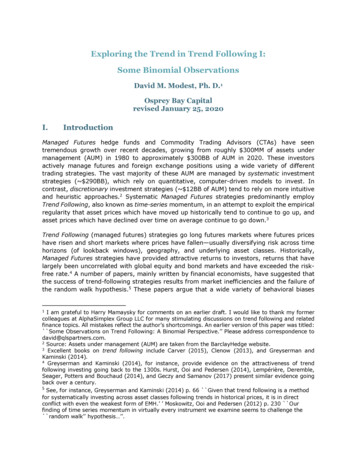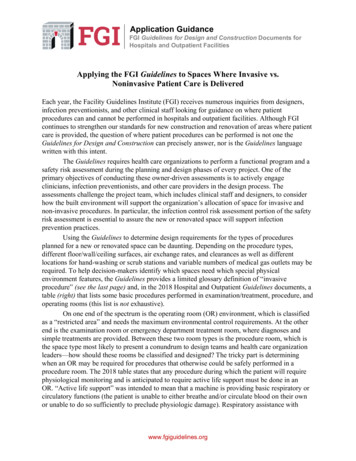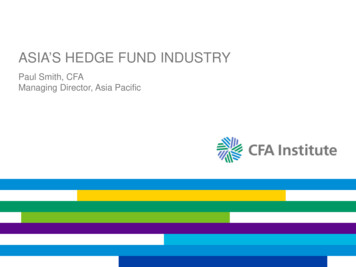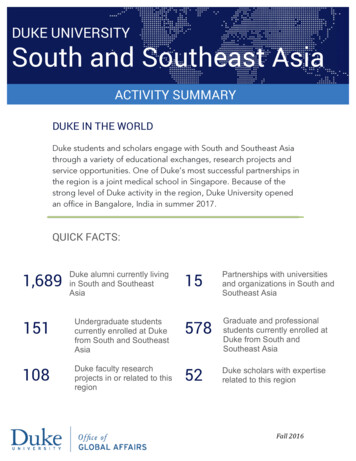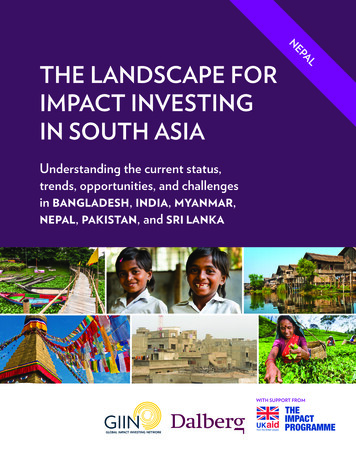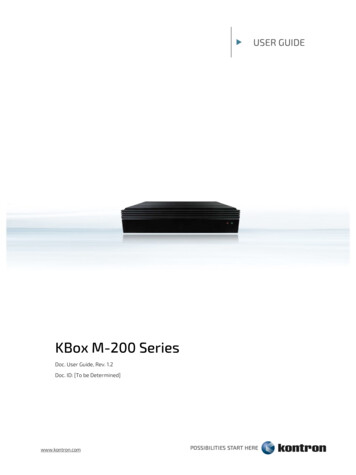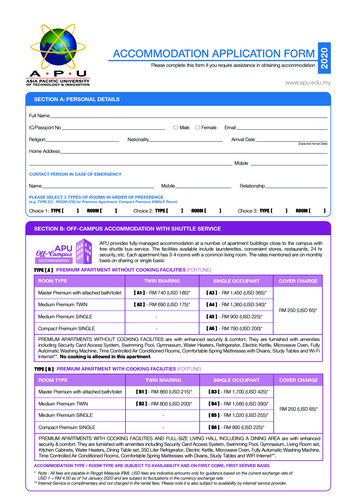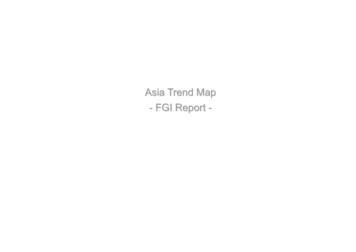
Transcription
Asia Trend Map- FGI Report -
Survey Outline1. Purpose of Survey:To understand the lifestyle of the middle class in Asian countries, including their consumption patterns, tastes and values in order to create and support strategicmarketing approaches to Asia that will utilize Japan’s strengths.2. Research Topics:1. To understand what kind of consumption trends and consumption values arise from basic consumption (clothing, food, homes and transport/portable devices,amusement, etc.) in each region.2. To understand what kind of image Japanese products now have and their potential for acceptance within these trends and consumer attitudes.3. Survey Method and Sample Size:Focus Group Interview / Total 8 Groups (48) * 2G 48s (8G x 6s) per city4. Countries Surveyed (Cities): 4 Countries (Cities)Hong Kong, Singapore, India (Mumbai), Thailand (Bangkok)5. Sample Criteria and Distribution:People who are in the middle class of each area (country) and who are active in the three areas of “Information Gathering, Consumption Trends and InformationDelivery.”Females: Those who have an interest in fashion, read fashion magazines frequently and spend money on clothing. * Excluding married women living with theirparent(s).Males: Those who have an interest in and consume entertainment content and own a car/motorcycle and mobile phone. * Automobile/motorcycle ownership will bedetermined depending on the situation.6. Sample Distribution / Question Content: 2 Groups per CountryFemale Group x 1G (6s): Hypothetical questions on clothing, good and homes・20-somethings (employed and married women) x 3s・30-somethings (married women with children) x 3sMale Group x 1G (6s): Hypothetical questions on transport/portable devices (mobile phones, cars, motorcycles) and amusement・20-somethings (employed and unmarried men) x 3s・30-somethings (employed and married men) x 3s7. Survey Dates (2010):Hong Kong: Monday, Jan. 25 – Tuesday, Jan. 26 / Singapore: Thursday, Jan. 28 / Mumbai: Saturday, Jan. 30 / Bangkok: Monday, Feb. 1
8. Middle Class Definitions:Hong KongSingaporeMumbai※※※※Data checked by research companies in eachcountry.Light blue fields indicate the middle class.India uses annual household income, whilemonthly income is used in other countries.Exchange Rates¾HK 1 JPY 12¾SGD 1 JPY 65¾INR 1 JPY 2¾THB 1 JPY 3Bangkok
Fashion
FashionJapanese fashion has penetrated the Hong Kong market the most, followed by Singapore, Bangkok and Mumbai.A number of Japanese fashion magazines are read in Hong Kong and people have experience with actual Japanese clothing at boutiques.There is not much information available in the other countries, where Japanese fashion’s image has been created by occasional experiencethrough just a few Japanese TV shows. Korean fashion has penetrated these markets more.As a result, information on Japanese fashion leans ultramodern and radical. It has a strong image of being too “excessive” and “extreme.” Anurgent task is to correctly deliver fashion information to large potential markets.Society & CulturalBackground Appearance and other people’sSingapore opinions are important. Rather thanwanting to be seen as upper class,there is strong desire to “avoidThere is not so much interestin fashion, perhaps becausethe climate is hot and humidyear-round.humiliation.” Mumbai BangkokPeople want to be seen asa little above their currentclass.Values are closer toWestern than Asian. Trendy Western clothes(including counterfeits) aresold cheap at outdoor stallsand are often worn by femaleoffice workers. Young people have begunmoving from traditional folkclothing to Western clothes,and both patterns exist. There is a strong desire to notbe seen as out-of-style orout-of-date and peopleenthusiastically take onparticular fashion styles (now, forexample, tight jeans) andpopular brands. There is highinterest in jeans brands. Many people care much aboutfitting their figure and trustbrands that do this. There is high interest in Westernfashion trends and there is littleawareness of Asian fashion. In contrast to Singapore,people pay some attentionto details and haverelatively high fashionsense in their preferences. Relatively stylish and trendyforeign brands like Zara andMNG are popular. People buy a lot of domesticbrands. Many popular brandsare geared toward femaleoffice workers (Jaspal,Chaps, etc.). One reason why people buydomestic and Asian brands isthat they think Westernbrands’ sizes don’t fit sincetheir build is generally small. Most women have jobs, so acceptancein the workplace is important. Fashion-Related DesiresFashion & Fashion-Related Desires in Each City 1Hong Kong People speak most highly ofshiman (being cultured andhumbly feminine) in fashion.People avoid fashion that is flashyand stands out too much becauseit is important that your peers caneasily approach and trust you.Men are also concerned aboutacceptance.People want simple,middle-of-the-road fashion and tofeel more like their true selves.Some end up wearing the sameclothes, and there is strongresistance to figuring out prices, sothere is little desire for “originalitems” or something “just for me.” There is little interest inthe latest fashion. Peopleplace more importance oncomfort in a hot climate andmobility more thanstylishness or trends.There is a strong taste forcasual clothing.People avoid loud colorsand shapes like in HongKong, but people inSingapore have little interestin fashion are thus satisfiedwith “neat” clothes, asopposed to the choicesmade in Hong Kong due toappearance and otherpeople’s opinion.
SingaporeMumbaiBangkokActual FashionInfo SourcesFashion & Fashion-Related Desires in Each City 2Hong Kong Main info sources aremagazines, TV shows, storeclerk recommendations andstorefront displays.Some mentioned theJapanese magazine Non-no. People get info from friends’fashion and magazines.They search online andcheck info at stores. Main sources are storefrontdisplays and magazines.Others include TV, theinternet, signs and tradeshows. People gather info frommagazines and the internetand check whether it suitsthem at the store.
Issues & Potential forJapanese ProductsImage & Expectations of Japanese FashionHong Kong・・・・・ Information and productsfrom Korean fashion havepenetrated more thanJapanese. People think“Japanese and Korean aresimilar.”People are drawn more toJapanese and Korean, that is,Asian fashion than Western. Itfits their figure.People basically have apositive impression ofJapanese fashion as “cute,”and “high quality (durablefabric, comfortable, etc.).”People praise creativecoordination and colorschemes.However, people don’t like thatinformation on commonJapanese fashion is notcommunicated properly.Their impression is that theycannot wear such clothesthat are “too much” like“incredibly short skirts withridiculously high heels,” etc.Japanese fashion magazines areeven sold on the streets.Japanese fashion information haspenetrated this country the mostout of the four.Even so, it is less than theamount of info on Korean fashion.Expanding promotions is anurgent task.In particular, introducing trendyfemale office work fashion thatsuits feminine tastes (i.e. shiman)would be effective.Singapore・・Foreign fashions peoplecheck are from Korea orother countries with similarclimates to Hong Kong,while most do not knowJapanese brands.Compared to Europe,Japanese fashion’s image ispositive, being “basic(standard),” “somethingyou can wear a long timeregardless of fashiontrends,” etc., although italso has an not veryfavorable image as being“too extreme” and “alwayslike school kids’ clothes.” Asin Hong Kong, only somedistorted information onadvanced fashion isdelivered and informationon common fashion is notconveyed correctly.There is little informationon Japanese fashion andpeople don’t have much ofan impression about it. First of all, it is important topublicize information on“comfortable” and casualfashion that addressconsumers’ most importantneeds. Mumbai・・・ People basically lean moretowards Western thanAsian fashion.There is almost noinformation on Japanesefashion, nor even anyawareness of it.People typically imagine ofJapanese dolls and geishawhen they think ofJapanese fashion.This country has the leastinformation on Japanesefashion out of the four.Many foreign fashions peoplecheck out are from the Westand are very popular.Consumers are veryconscious about status andbrands, so it is important tonot just put out a product, butto think carefully about abranding strategy.Bangkok・ Korean fashion has deeplypenetrated the market here.・ There is little information aboutJapanese fashion. What isoccasionally seen is “reallygaudy” or “really plain.”・ The impression is that it issimply extreme. It seems tocome from occasionalinformation they get on Harajukufashion and such, or from thesimple clothes of Japanesehousewives that appear in onlyJapanese TV program (varietyshow).・ People know about the Japanesebrand Muji, but its image is that it“feels natural,” which is neithergood nor bad.・ Colorful fashion like Zara andstyles that feel more femininewould probably be more easilyaccepted in Bangkok thanexcessive styles like Harajukufashion or Muji’s simpleapproach. Although there is someinformation from Japan,fashion’s image is limitedbecause there is noinformation that focuses on it.The first thing to do to improveJapanese fashion’s image isto export information throughfashion magazines, TVdramas, etc.
Food
FoodIn all four of the countries surveyed, we saw food incorporating foreign cuisine in households wanting meals to be original and colorful.Consumers in each city currently place importance on the following: safety in Hong Kong, flavor and convenience in Singapore, flavor in Mumbai andhealthiness and beauty in Bangkok.Except for Mumbai, Japanese products are widely available. Consumers trust them for being high quality and safe, and they have established a positivereputation as have good flavor.Japanese products still don’t have recognition in Mumbai.Society & CulturalBackgroundCulinary DesiresFood & Culinary Desires in Each CityHong KongSingapore People love to eat out. Manyeven eat out for breakfast. Consumers don’t trust foodfrom the Chinese mainland asbeing safe. People have a strong desire forsomething original usingWestern cooking or Japanesefood rather than the exclusivediet of Chinese food theirparents made and put on thetable. Not only are nutritional balanceand flavor preferencesimportant, but so ispresentation. People do not trust the safety offresh produce if its place oforigin is not listed, so they havea strong interest in place oforigin labeling. They are alsointerested in organic foods. They won’t likely deviate fromtheir healthy inclinations. Deliciousness and simplepreparation are most important. Accordingly, there is a strongdesire for processed andpre-cooked foods that are quickto prepare. Imports from Australia, NewZealand, Japan and elsewhereare thought of as being topquality, while consumers want toavoid suspicious Chinese-madeproducts. Although Singaporeans areinclined towards healthiness andthe above-mentioned safetyconcerns, they are not incrediblysensitive about these issues.“Deliciousness” is a higherpriority. Many eat simple meals forlunch and breakfast at arestaurant or at home.Singapore’s healthstandards are strict, but theymay be influenced byrelatively relaxed attitudestowards foreign products,particularly Chinese.MumbaiBangkok Some foods are restricted byreligion and people adhere strictly.Certain segments of the populationinclude vegetarians who eat no meator fish at all and followers ofJainism who, in addition to meat andfish, do not eat anything that growsunderground. Many households have maids, butcooking, particularly adding spicesand flavoring, is a housewife’swork. Among people with Chineseheritage, some were seenhere and there who do not eatbeef for religious reasons. People really love to eat outand many women do not cookby themselves because inmany cases they work andparents or siblings help withhousework. Young people want a lot ofvariety and originality ratherthan the mainly orthodox,standard dishes made by theirparents. With the abundance ofagricultural produce, many placeimportance on freshness withfoods such as meat, fish andvegetables. People think a lot about beautyand health trends, and manyover fatty foods. Food’s “appearance” shouldlook delicious. People eat a high proportion ofhome-made food at homecompared to other areas andinfrequently use processedfoods.Instant soups and cups of instantnoodles are eaten, but they arerather snacks.There are extremely highparticular preferences forgood flavors.There is high interest in beauty(dieting) and health, but “flavor”is a higher priority.There is a strong interest inforeign cooking, with popularfoods including richly flavoredItalian, Mexican and Chinese.In contrast to Indian food, whichtends to look plain, nicepresentation and easy-to-carryfoods have appeal.
Hong Kong Many homes make use of Japanesefoods such as seasoning and instantnoodles and think very highly ofthem. Japanese food’s safety, good flavor,abundant variety, simplepreparation, etc. do a lot to make itImage of Japanese-Made Food Products & IngredientsImage and Expectations of Japanese Products 1appealing. Some specific popular items that arebought and why are listed below:Soy sauce: “Tastes good with Chinesefood.”Seasoning: “Lots of variety to choosefrom.”Eggs: “They’re very sweet and haveauthentic egg flavor.”Pasta sauce: “Lots of selection,” “Caneat straight from the container,” “Smallportions are easy to use.”Sesame oil: “It’s aromatic.”Carrots and daikon radishes: “They’retasty.”Snacks: “The packages look nice,”“They’re tasty.”Sesame dressing: “It goes withanything.” Except for a very few brands thatappear in the media like Demae Itchoand Cup Noodle, most are unknownand people judge whether a product isJapanese by the Japanese lettering orpackage des
A number of Japanese fashion magazines are read in Hong Kong and people have experience with actual Japanese clothing at boutiques. There is not much information available in the other countries, where Japanese fashion’s image has been created by occasional experience through just a few Japanese TV shows. Korean fashion has penetrated these markets more. As a result, information on

